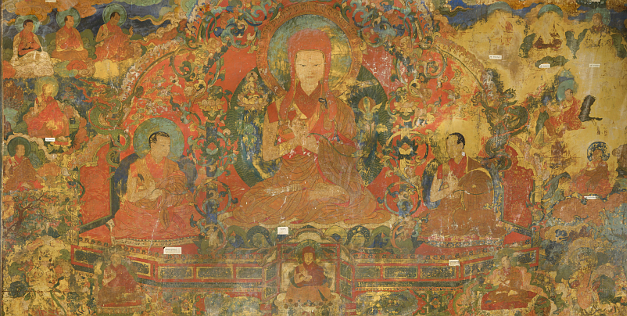Art of Khyentse Chenmo (Khyenlug)
The Khyentse art tradition is closely associated with the Dzongpa tradition as Gongkar Choede was home to its founder, the great fifteenth century artist, Khyentse Chenmo Genyen Nampar Gyalba and the paintings for which he was best known were executed near his birthplace at the monastery, within the years 1464-65, under the direction of the monastery’s founder, Gongkar Kunga Namgyal with whom he had a very close relationship. Traditional Tibetan religious art can be broadly classified into two schools, Menri and Khyenri. Both of these schools were named after their founders: Menri after the Great Menthangpa and Khyenri after Khyentse Chenmo of Gongkar.
Khyentse Chenmo was born in Gongkar Gangtoe, just outside the monastic precincts Gongkar Choede. Although, not much is known about the exact year of his birth, it is known that he painted the murals of the main assembly hall of Gongkar Choede monastery depicting the “The Wish Fulfilling Vine” (Paksam Trishing). Khyentse executed not only wonderful murals but also special thangkas for his patron and lama Gongkar Dorjedenpa. In addition to his mastery of painting, Khyentse was also famed as an extraordinarily skilled sculptor. The chapels of Gongkar Dorjeden contained many large statues that he had made, some of them reaching the height of from one-and-a-half to two-and-a-half stories. His images of fierce protectors were wonderfully terrifying, and his sculptures of the Lamdre lineage masters were both said to be extremely realistic and remarkably well preserved, remaining as if freshly varnished down until the 1920s and later. Not a trace remains of any of these figures. All the statues at Gongkar were annihilated and the top-floor temples were razed in the 1960s when the monastery’s main assembly hall was converted into a grain warehouse and one upper story was preserved for use mainly as Communist party offices.
The 11th Situ Rinpoche visited Gongkar Choede during his travels in U-Tsang in 1918 and mentions seeing the murals in the assembly hall and the deity room in his travel account. In a chapter about the directions for constructing a Dorje Trengwa Kyil Thang (Vajra-Mala Mandala Field) in the second volume of his autobiography, the Great Fifth Dalai Lama talks about the Khyenri school. Comparing the Menri and Khyenri styles in their depictions of wrathful and peaceful deities, he regards the Khyenri as the masters of depicting wrathful deities and Dharma protectors.
Khentse, an adept at painting, also tried his hand at relief works. Relief works with his depictions of Buddha Shakyamuni and the eight close disciples, Chakrasamvara-Vajravarahi, Brahma and Vishnu, and two wrathful sentries can be seen inside the assembly hall of Gongkar Choede.
Drum Dance (Nga Cham)
The Gongkar Choede drum dance is an important part of the arts and culture tradition of Tibetan Buddhism. The Lord of the oral tradition, Tsarchen Losel Gyatso (1502-1566/67), praised the founder of this drum dance, Kunga Namgyal (1432-1496), in this way: “Dorjedenpa Kunga Namgyal is the Lord of Power and Strength and of the Lama Dance”. The Gongkar Choede drum dance is one of the many different kinds of ritual dance established by Dorjedenpa Kunga Namgyal, with written instructions on their performance and in accordance with the dance movements explained in the Vajra Panjara Tantra. This drum dance was performed annually at his seat, Gongkar Dorjeden, on the fifteenth day of the first Tibetan month, during the occasion of the Great Prayer Gathering. Gradually its fame spread over Tibet and it was performed every year during “The Procession of the Assembly of Worship” at the anniversary of Fifth Dalai Lama. His Holiness the Fourteenth Dalai Lama has expressed his appreciation and fondness of the Gongkar Choede Lama drum dance.
